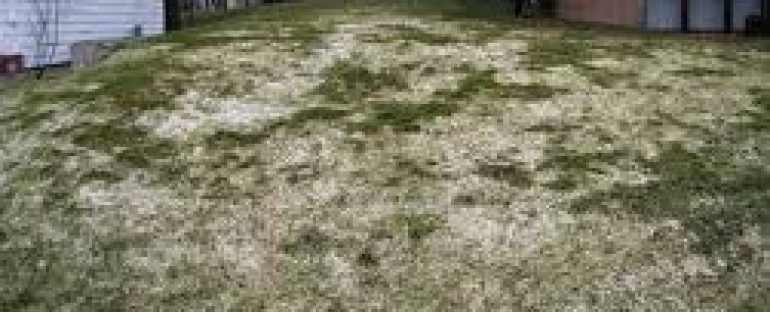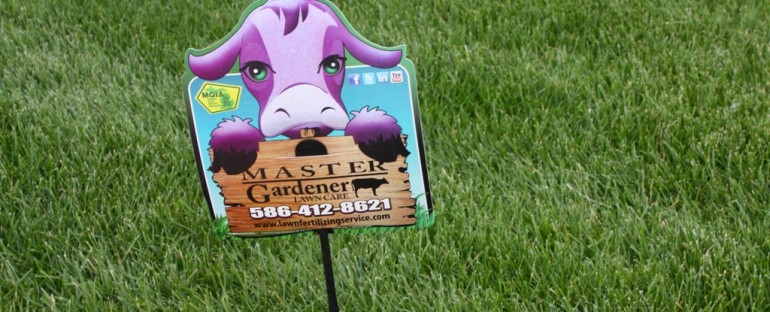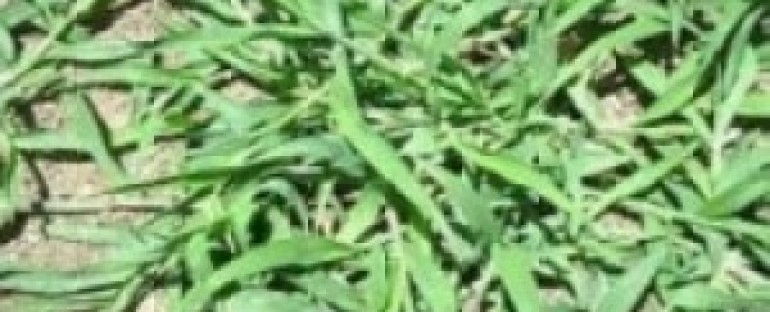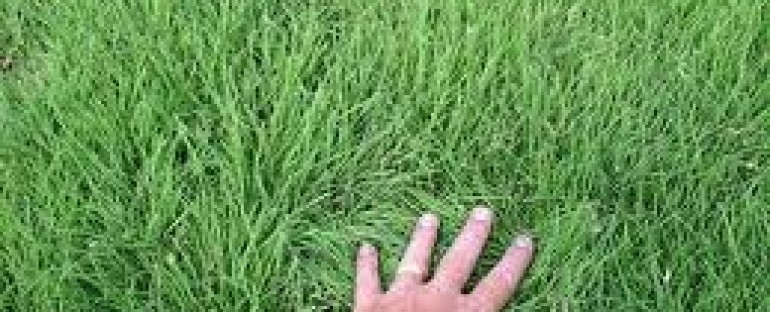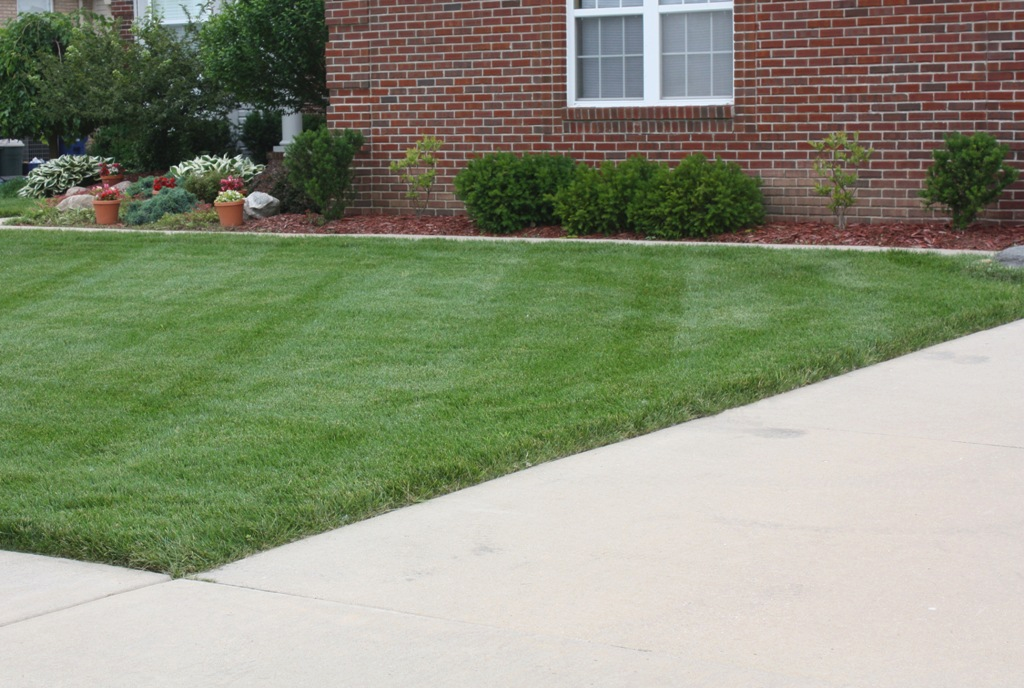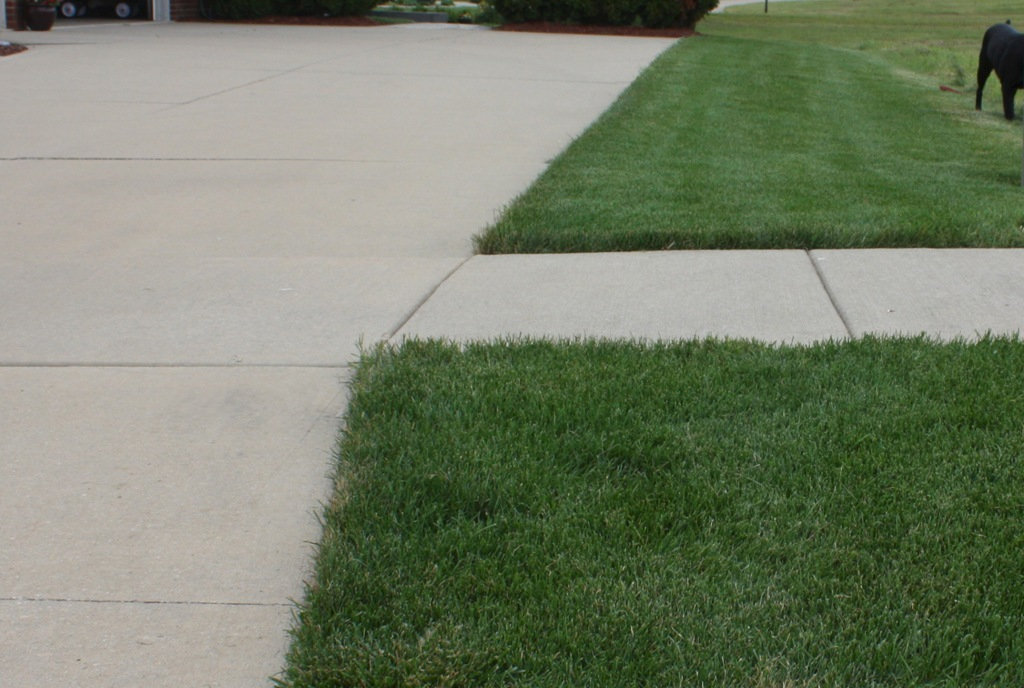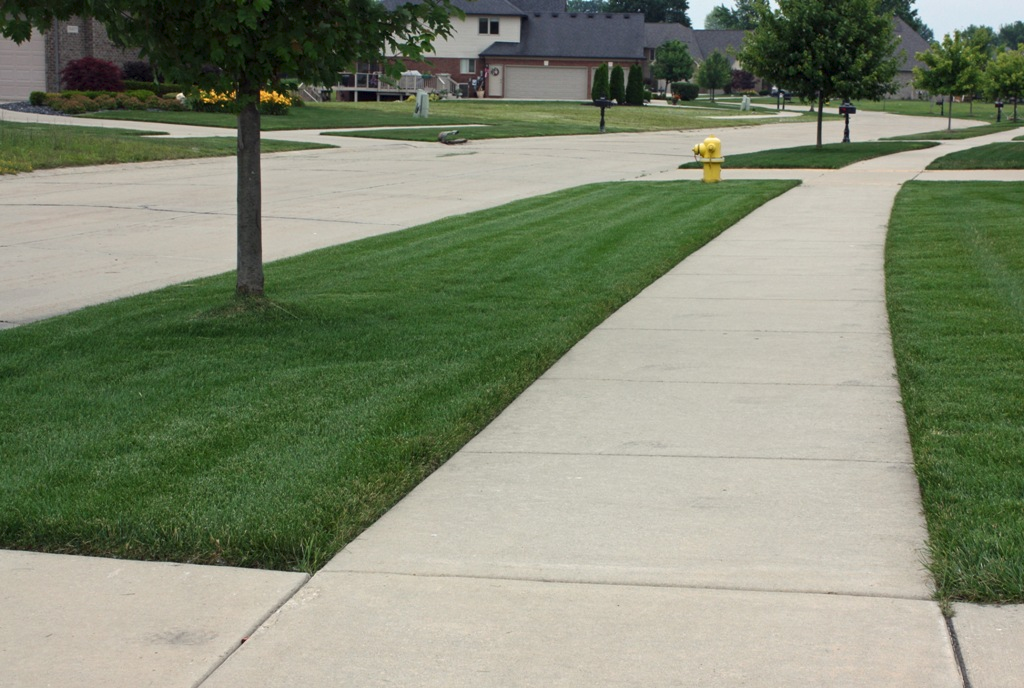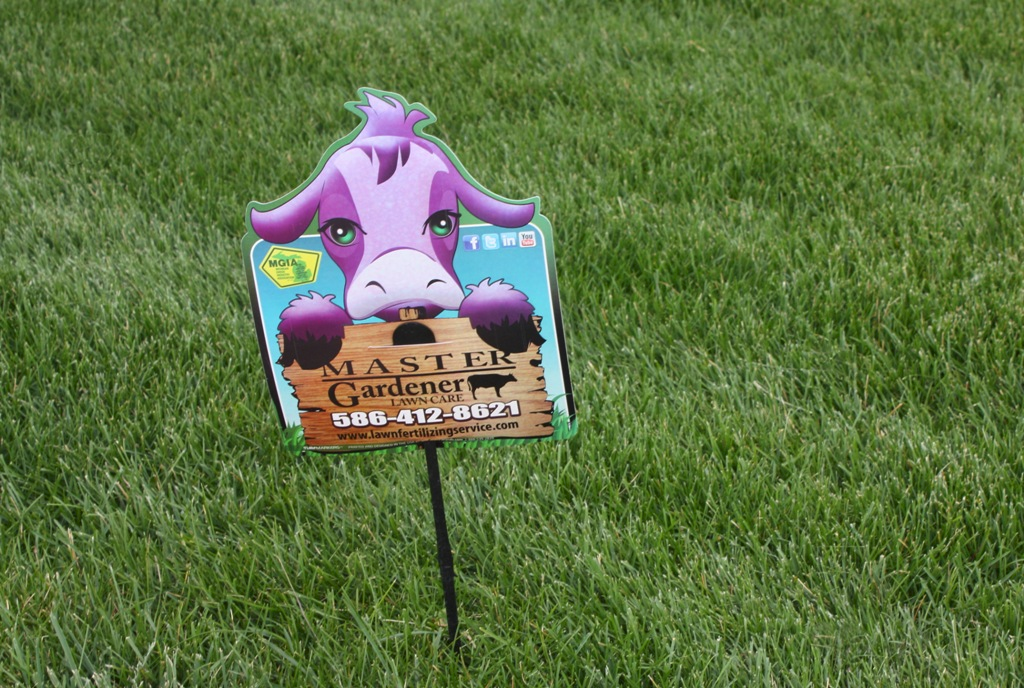Welcome to Master Gardener Award-Winning Lawn Fertilizing Service operating in Macomb County, Michigan
 When the Michigan snow melts in the next few weeks in Macomb and Berrien County you might be in for a surprise.  And that surprise is gray or pink snow mold. The good news is that in most cases these two issues won’t require much attention on your part. But Master Gardener Lawn Fertilizing Service will get calls from our clients and others asking us what is happening to their lawns. So we think it is important to talk about these snow molds. Gray Snow Mold is what we see most of in Macomb County and our Master Gardener Lawn Care location in Berrien County.  Like the name suggest it is recognized by the white to gray color. No need to worry!  This issue will clear up with the help of a little light raking. Just rake the affected area to allow the air to circulate and the snow mold will begin to diminish. Your first lawn fertilizing application will also help the process by providing nutrients to your lawn which help the turf to grow and recovery. Pink Snow Mold is little more serious of the two. It has a pink to salmon color. Again the first lawn fertilizing service application will stimulate the lawn to grow and the lawn should recover. Light raking of the damage turf will also help to speed up the recovery. There is more of a chance that pink snow mold damage may need to be over seeded.  Wait and see if your lawn recovers before taking any additional action. Please note that if you seed at this time you cannot apply a crabgrass pre-emergent. This pre-emergent will also prevent the grass seed from germinating. Read the label on the bag of the pre-emergent to see when it is safe to apply without interfering with the germination of the grass seed. Note: It is possible to see both gray and pink snow mold on the lawn together. Why do some lawns get snow molds and some do not? The number one cause of gray or pink snow mold is having snow on the lawn for an extended period of time. Try to eliminate large piles of snow in the same spot year after year. Master Gardener Lawn Care is an Award-Winning Lawn Fertilizing Service with operations in Chesterfield Township. Master Gardener Lawn Care was founded and is operated by a Certified Master Gardener.  About the Author Patrick Wesley is a Master Gardener and part owner of Master Gardener Lawn Care located in Macomb County, Michigan.  Master Gardener Lawn Care provides an organic based lawn fertilizing service in Macomb Township, Shelby Township, Washington Township, Chesterfield Township, New Baltimore, Clinton Township, Warren, and Sterling Heights in Macomb County, and St Joseph, Benton Harbor, Bridgeman, Coloma, Hartford, Watervliet, and Stevensville in Berrien County, Michigan. Master Gardener Lawn Care was established in 1991 and provides lawn fertilizing service, core aeration, weed control, soil testing and insect control. For more information on our lawn care and lawn fertilizing services or to request a free lawn care analysis please visit our Free Lawn Fertilizing Service Estimate page on the mastergardenerlawncare.com website
Master Gardener Lawn Care is an Award-Winning Lawn Fertilizing Service with operations in Chesterfield Township. Master Gardener Lawn Care was founded and is operated by a Certified Master Gardener.  Frequently, when presenting the Master Gardener customized lawn care program to potential customers, I’m asked “why is Master Gardener Lawn Care different than other lawn fertilizing services”. I’m proud to point out our advantage in the areas of our people, education, products and service.  In the 23 years that we have been operating a lawn fertilizing service, we’ve learn that it is very difficult to find people that share the same passion for the customer and customer service as an owner. Over the years we have developed a unique opportunity to provide ownership to the best and brightest lawn care people. So there is a very high probability that the person servicing your lawn is an owner and as an owner of Master Gardener Lawn Care he has the passion in providing you with the very best service.    All the owners have the State of Michigan required certifications to treat your lawn and attend continuous educational programs each year to maintain these certifications. We all have college degrees and several of us have graduate degrees. We are very proud that Master Gardener Lawn Care is one of the best educated lawn fertilizing services in Macomb County. We are qualified to work in many other industries but embrace the passion of caring for your lawn.  It is a great testimony to our work when our suppliers tell us that other lawn fertilizing services want to know what products we are applying. Our suppliers stock products that are at a price point that will move quickly. That is good for the suppliers’ inventory turnover but may not be the best product for your lawn. We choose to special order products that we feel are a better match for the conditions at the time. We may pay more for our special order products but we want what is best for our customers. These products help us maintain our 99% customer retention rate and we feel are worth the additional cost. I can also say with great confidence that it is rare that another lawn fertilizing service is treating lawns with same products as Master Gardener Lawn Care.  At Master Gardener Lawn Care we take pride in providing outstanding service. When there is a request for an estimate we visit every lawn. We provide a written analysis and starting this year in Chesterfield Township all current customers and new customers will receive a free soil test. The soil test will aid us in adjusting your lawn fertilizing program, if need, to achieve the best results.  At Master Gardener Lawn Care we are always on the leading edge of new products like Hydretain which can reduce your watering requirements by 50%. No other lawn care company in Michigan is offering this product.  All Master Gardener Lawn Care owners work smart to provide the best products and service so we can showcase our customer lawns. This allows our customers to brag and be proud of their lawns and often refer us to their neighbors and friends.  Over 90% of our new customers are from referrals. We treat each referral is our customers’ testimonial to our outstanding products and service.  About the Author Patrick Wesley is a Master Gardener and part owner of Master Gardener Lawn Care located in Macomb County, Michigan.  Master Gardener Lawn Care provides an organic based lawn fertilizing service in Macomb Township, Shelby Township, Washington Township, Chesterfield Township, New Baltimore, Clinton Township, Warren, and Sterling Heights in Macomb County, and St Joseph, Benton Harbor, Bridgeman, Coloma, Hartford, Watervliet, and Stevensville in Berrien County, Michigan. Master Gardener Lawn Care was established in 1991 and provides lawn fertilizing service, core aeration, weed control, soil testing and insect control. For more information on our lawn care and lawn fertilizing services or to request a free lawn care analysis please visit our Free Lawn Fertilizing Service Estimate page on the mastergardenerlawncare.com website
To: MGLC Clients  Subject: 2014 Season Thank you for your business as we begin our 23rd year of providing the best fertilizing products and service to our neighbors.  It is hard to believe that your first application to another Master Gardener Lawn Care remarkable lawn is just around the corner. It looks like we might be starting a little later than normal. We want to make sure the lawns are dry. In any case we are ready for the challenges of the 2014 season. SOIL TEST   Last year we performed several hundred soil tests in Macomb Township and the results were consistently very surprising. Because of these unexpected results we are expanding our soil testing program to Chesterfield Township. Several years ago the State of Michigan passed a law that eliminated some key ingredients in fertilizer. We are now seeing the effects of this action which can only be proven by a soil test. So if you see me or one of my techs taking some soil samples from your lawn you know what we are up to. The tests should be back in our office by June 1st. The results will help us adjusted your fertilizer program for the next few years. Please feel free to call if you would like to discuss your soil test. Also, because we feel that it is very important to perform these soil tests, Master Gardener Lawn Care will be absorbing the cost.  CREDIT CARD PAYMENT  We are again offering the opportunity to pay with a credit card. We have made it quick and easy by contracting with the very safe E-Bay owned company PAY PAL. Here your personal information is kept confidential. You can log on to our website to make a payment. We are also able to accept credit card payments at your door. Just let me know when I’m treating your lawn.  REFERRAL PROGRAM – GREAT SAVINGS!   We would like to thank everyone for last year’s referrals. They are greatly appreciated! We will continue to deduct $20.00 OFF your next application when a friend or neighbor signs-up for our program. Plus your friend will receive $20.00 OFF their first application. Again, we greatly appreciate your help and want to thank you for spreading the word.   We look forward to seeing you soon. Meanwhile, if you have any questions please feel free to call my cell (586-321-8505). Thanks, Pat    Master Gardener                             Please go to www.mastergardenerlawncare.com to learn about the purple cow.  Member of: Michigan Green Industry Association
Preemergence Herbicide Applications for Crabgrass Control I would like to share this article written by our friend Kevin Frank from Michigan State University. Spring has been very slow to arrive, but models indicate many areas of central and southern Michigan may soon be in the optimum application window for preemergence herbicides. Posted on April 12, 2013 by Kevin Frank, Michigan State University Extension, Department of Plant, Soil and Microbial Sciences Unlike the spring of 2012, the spring of 2013 is off to a very slow start with cool temperatures and soaking rains the last week (as of April 11). As tax day approaches, there have been several inquiries within the last week not about deductions, but about when to apply preemergence herbicides for crabgrass control. Summer annual grasses such as crabgrass require proper soil temperature and moisture to germinate and establish. Eighty percent of germination will occur when the 0-2 inch depth soil temperature is consistently reaching 60 to 70 degrees Fahrenheit. For preemergence herbicides to be effective, they need to be applied before the soils reach this optimum temperature range. For example, soil temperatures at the Hancock Turfgrass Research Center on the Michigan State University campus indicate soil temperatures still hovering in the low to mid-40s. We have a growing degree day (GDD) model available at GDDTracker.net that uses GDD to indirectly measure soil temperatures in a turf situation (enter your zip code under the map and then click on the Crabgrass PRE button). As with all models, discretion and understanding of local conditions should be considered. The target range for this model attempts to predict when the 0-2 inch depth soil temperatures consistently reach 50 to 55 degrees F and therefore provides adequate time for the preemergence herbicide to be applied and watered in before crabgrass germination occurs. According to Michigan State University Extension, preemergence application timing for crabgrass in Michigan is usually between April 15 and May 15. Using prediction models at GDDTracker.net indicate that with the exception of a small area just north of the border near Toledo, Ohio, the entire state is still either in the “Early” or “Under” application window. Areas in the “Under” application window may be days from being bumped up to the “Early” application window or for areas under snow may be several weeks or more away. The most common question right now is if your location is in the “Early” application window, whether or not preemergence applications at this time will be effective. Applying preemergence herbicides in the “Early” application window is effective and most professional lawn care companies will time applications on the early side because of the reliable medium and long-residual herbicides that are available and the number of properties they are treating. Most homeowners are probably waiting for the first warm weekend in mid-April, often coinciding with the “Optimum” period to make their application. A good, environmental indicator for the “Optimum” period that I have not witnessed yet this year is to look for when forsythia bushes are blooming with their bright yellow flowers. Whether you target your application for the early or optimum window, remember the practices that encourage a healthy, dense turf stand such as mowing high, returning clippings, and adequate fertilization are all part of an effective crabgrass prevention strategy. Smart gardening tip sheets Mow high for weed and grub control Dr. Frank’s work is funded in part by MSU‘s AgBioResearch. This article was published by Michigan State University Extension. For more information, visit http://www.msue.msu.edu. To contact an expert in your area, visit http://expert.msue.msu.edu, or call 888-MSUE4MI (888-678-3464). About the Author Patrick Wesley is a Certified Master Gardener and Owner of Master Gardener Lawn Care located in Macomb County, Michigan.  Pat’s Company, Master Gardener Lawn Care, provides organic based lawn fertilizing services in Macomb Township, Shelby Township, Washington Township, Chesterfield Township, New Baltimore, Clinton Township, Warren, and Sterling Heights in Macomb County, Rochester Hills, Troy, and Royal Oak, Berkley Huntington Wood in Oakland County and St Joseph, Benton Harbor, Coloma, Steve in Berrien County, Michigan. Master Gardener Lawn Care was established in 1991 and provides lawn fertilizing services, core aeration, weed control, soil testing and insect control. For more information on our lawn care and lawn fertilizing services or to request a free lawn care analysis please visit our Free Lawn Fertilizing Service Estimate page on the www.mastergardenerlawncare.com website Â
Before I tell you about the most powerful tool in lawn care, the tool that will get you to a remarkable showcase lawn, let’s talk about fertilizer. When you purchase fertilizer, whether it is for your lawn, trees or scrubs, you will notice three numbers on the bag. These numbers represent the  (N) nitrogen, (P) phosphorus and (K) potassium. These are the major nutrient needed for a plant to remain healthy and survive. All three of these nutrients must be present and at optimal levels for the turf to thrive.  A few years ago the State of Michigan passed a law banning the major and very necessary nutrient (P) phosphorus. This nutrient is needed for root development and for the plant to thrive. So you will notice on many turf fertilizer products that the middle number is now zero.  By law as a licensed lawn fertilizing company we cannot apply a product containing (P) phosphorus.   The summer of 2012 was the first time in the twenty years that Master Gardener Lawn Care has been performing Soil Tests that we have seen low (P) phosphorus levels. The ban of a few years ago is starting to affect the health of our turf. Scientifically a plant cannot continue to survive without one of its major nutrients.  There are two exceptions to this regulation. The first one is, if we are fertilizing a newly seeded law. Remember (P) phosphorus is required by plants in developing a strong root system. The second is if the soil is determined to be low or deficient in (P) phosphorus. The only way to real know that a plant is in need of (P) phosphorus is by performing a SOIL TEST.  So, the SOIL TEST is now the most powerful tool in lawn care and in the lawn fertilizing industry.  A soil test is the only way we can determine the (P) phosphorus level in your soil. Once we have the current level we can calculate the amount of (P) phosphorus that needs to be added to the soil.               There are many other helpful things, such as pH, that a soil test can tell you. But for this discussion we are only considering (P) phosphorus.  Please note that the only way a truly customized lawn care program can only be developed is also with the help of a soil test.  So if someone is promising a customized lawn fertilizing program you may want to ask to see the soil test it is based upon.  Master Gardener Lawn Care has been creating award winning lawns for over twenty years. We are members of and abide by the firm code of ethics of the Michigan Green Industry Association. We provide lawn care services in Macomb, Oakland and Berrien Counties. About the Author Patrick Wesley is a Certified Master Gardener and Owner of Master Gardener Lawn Care located in Macomb County, Michigan.  Pat’s Company, Master Gardener Lawn Care, provides organic based lawn fertilizing services in Macomb Township, Shelby Township, Washington Township, Chesterfield Township, New Baltimore, Clinton Township, Warren, and Sterling Heights in Macomb County, Rochester Hills, Troy, and Royal Oak, Berkley Huntington Wood in Oakland County and St Joseph, Benton Harbor, Coloma, Steve in Berrien County, Michigan. Master Gardener Lawn Care was established in 1991 and provides lawn fertilizing services, core aeration, weed control, soil testing and insect control. For more information on our lawn care and lawn fertilizing services or to request a free lawn care analysis please visit our Free Lawn Fertilizing Service Estimate page on the www.mastergardenerlawncare.com website Â
While performing several free lawn analysis today, I noticed some SNOW MOLD in Shelby and Clinton Townships. It is nowhere as invasive as in the past and I was a little surprise to see any at all this year. Normally we see snow mold only after the snow has been on the lawn for several weeks.  This year the snow was lighter and was never on the lawns more then a week or two.  If you see some areas on your lawn, now that the snow is gone, that look like the pictures below it may be gray or pink snow mold. The good news is that in most cases this won’t require much attention on your part. But we do get call from our clients asking what is happening. Gray snow is what we see most of in our area. Like the name suggest it is recognize by the white to gray color. No need to worry it will clear up with the help of you first fertilizing application. You can help the process by lightly racking the area to allow air to circulate and speed up the recovery of the damage turf. Pink snow mold is little more serious of the two. It has a pink to salmon in color. Again the first fertilizing application will stimulate the turf to grow and the lawn should recover. Light raking will also help to speed up the recovery. There is more of a chance that pink snow damage may need to be over seeded.  Wait and see if it recovers. I have seen both gray and pink snow mold on lawns together. If you are concern about the condition of your lawn at this time of year, please feel free to call Master Gardener Lawn Care LLC for a free lawn analysis. We would be thrilled to treat your lawn or advise you on the best products available for you to create a showcase lawn. Master Gardener Lawn Care has been creating award winning lawns for over twenty years. We are members of and abide by the firm code of ethics of the Michigan Green Industry Association. We provide lawn care services in Macomb, Oakland and Berrien Counties. About the Author Patrick Wesley is a Certified Master Gardener and Owner and Director of Operations for Master Gardener Lawn Care located in Macomb County, Michigan.  Pat’s Company, Master Gardener Lawn Care, provides an organic based lawn fertilizing service in Macomb Township, Shelby Township, Washington Township, Chesterfield Township, New Baltimore, Clinton Township, Warren, and Sterling Heights in Macomb County, Rochester Hills, Troy, and Royal Oak, Berkley Huntington Wood in Oakland County and St Joseph, Benton Harbor, Coloma, Steve in Berrien County, Michigan. Master Gardener Lawn Care was established in 1991 and provides lawn fertilizing service, core aeration, weed control, soil testing and insect control. For more information on our lawn care and lawn fertilizing services or to request a free lawn care analysis please visit our Free Lawn Fertilizing Service Estimate page on the mastergardenerlawncare.com website Â
Moisture Manager Reduces Watering by 50%.  Master Gardener Lawn Care is an Award-Winning Lawn Fertilizing Service operating in Macomb, Oakland and Berrien Counties that was founded by a Master Gardener. At Master Gardener Lawn Care we are always looking for products and services that will provide our clients with the best lawn in their neighborhood at the best possible cost. One product that we have recently researched, HYDRETAIN, is proven to reduce watering requirements by 50%. Please see the information below and if you are interested feel free to give us a call. Hydretain by Ecologel Solutions LLC is a patented blend of liquid humecÂtant and hygroscopic compounds that attract free water molecules from the air within the soil. That water is then available to plant roots. Hydretain creates a sub-surface film that collects and stores moisture on plant roots and soil particle surfaces. What does all this mean? Consider what hapÂpens when you fill a glass with a cold drink. EventuÂally, water begins to condense on the side of the glass. The soil works in much the same way when Hydretain is applied. At the time that plants would normally go into drought stress, there is a very high level of humidity in the soil that is typically lost to evaporation. Rather than allowÂing that moisture to escape to the atmosphere above, Hydretain attracts the molecules of water and keeps that moisture in the soil. Hydretain captures water that is already there, reducing the irrigation or rainfall required to deliver adequate water to plant and turf roots. This is what makes Hydretain a unique water conservation and landscape management tool. According to Ecologel Solutions, you can water 50 percent less with Hydretain. So for areas where water restrictions are in place, landscape conÂtractors can maintain the integrity of properties while adhering to requirements. And in areas where water savings is not yet an issue, Hydretain minimizes drought-stress cycles between rainfall and irrigation, promotes healthier plants and ultimately delivers a better quality landscape.  Hydretain Root Zone Moisture Manager will:       Double or even triple the days between required watering       Reduce or eliminate drought stress cycles       Enhance seed germination       Control or eliminate dry spot problems       Improve transplant establishment       Protect non-irrigated or poorly irrigated areas   “Hydretain” – Top 10 Frequently Asked Questions Q. What is Hydretain? How does it work? A. Hydretain is blend of patented hygroscopic and humectant compounds that is applied to the root zone of plants. This coats the roots and converts subsurface humidity into usable water for the plants. Q. How is Hydretain applied? A. Until recently, Hydretain was only applied by a spray or drench. For lawns, diluted Hydretain is sprayed onto the grass and then watered in so that it reaches the root zone. For ornamental plants, shrubs and trees it is drenched into the root zone. Q. When should Hydretain be applied? A. Hydretain can be applied anytime during a plant’s life cycle. However, the best time to apply Hydretain is before hot dry weather or drought conditions set in. Q. How long does Hydretain last? How often should it be applied? A. Hydretain lasts up to 3 months before it biodegrades. Re-apply at least every three months or more often for even greater water conservation. Q. Is Hydretain safe? Will it harm my pets? A. Hydretain is primarily made from food-grade ingredients and natural plant extracts. It is non-toxic. It will not harm your pets. Q. Is Hydretain beneficial to my bedding plants, shrubs and trees? Fruit trees and vegetable gardens? A. Hydretain has been proven effective through University of Texas and Florida trials and independent use on most types of ornamental plants, shrubs, trees, grasses and food producing agricultural plants. Q. When will I see results? What type of results should I expect? A. Hydretain becomes effective when it is drawn up against plant roots, generally within one to two waterings after the initial application. Results may vary, a 35% to 50% reduction in normal watering requirements is expected. Q. Will Hydretain hold too much water if we get a heavy rain fall? Will Hydretain wash through the soil with heavy rainfall?  A. Hydretain has little moisture holding capacity. Its function is to convert soil humidity into plant useable droplets when water is no longer available to plant roots. Hydretain may wash through the soil if heavy rainfall follows closely after application, before Hydretain has time to attach to plant roots. Hydretain is usually drawn up against roots within the first one to two required waterings after application. Q. Is Hydretain safe to use with other lawn care products? A. Yes, as a general rule Hydretain may be used with most other lawn care products. Hydretain has been shown to help improve the uptake of nutrients and assist in the function of pesticides and fungicides. Q. Is Hydretain beneficial if I don’t water at all? A. Hydretain has proven to reduce watering requirements by as much as 50% or more, however, if no watering is done and there is no rainfall, eventually plants and turf will go into normal drought stress.  About the Author Patrick Wesley is a Master Gardener and part owner of Master Gardener Lawn Care located in Macomb County, Michigan.  Master Gardener Lawn Care provides an organic based lawn fertilizing service in Macomb Township, Shelby Township, Washington Township, Chesterfield Township, New Baltimore, Clinton Township, Warren, and Sterling Heights in Macomb County, Rochester Hills, Oakland Township, Troy, Royal Oak, Berkley, and Huntington Woods in Oakland County, and St Joseph, Benton Harbor, Bridgeman, Coloma, Hartford, Watervliet, and Stevensville in Berrien County, Michigan. Master Gardener Lawn Care was established in 1991 and provides lawn fertilizing service, core aeration, weed control, soil testing and insect control. For more information on our lawn care and lawn fertilizing services or to request a free lawn care analysis please visit our Free Lawn Fertilizing Service Estimate page on the mastergardenerlawncare.com website
We received this e-mail form Michigan State University Extension and would like to share it with our customers at Master Gardener Lawn Care LLC. Common suspects involved in winter landscape damage Identify these pesky, winter, landscape pests by the location of the damage they cause. Posted on January 4, 2013 by Gretchen Voyle, Michigan State University Extension Winter appears to be a time of snowy peace when viewing the landscape outside the windows. But in reality, it is a very busy time for a number of animals. Some critters that may cause landscape damage during the growing season hibernate or partially hibernate during the winter and don’t feed. The woodchuck and thirteen-lined ground squirrel sleep the winter away underground. The eastern chipmunk partially hibernates and may pop above ground occasionally if its food stores run low. The amount of snow and how long it lasts, as well as how much really cold weather we receive, determines if this winter will cause critter problems. Last winter (2011-2012) could be called “The Winter that Wasn’t.” When small amounts of snow fell, it warmed up in the next several days and most of it melted. Animals could gather plenty of food in fall and put on a nice layer of fat that helped them survive and stay warm. During the winter, finding extra food was not too difficult. The 20120-2013 winter is different. We have had colder weather and more snow cover by January than all of the last winter. The most common animals to take a literal bite out of your landscape are the ones that are active during the winter, like the whitetail deer, cottontail rabbits and meadow voles. Let’s start at the ground where damage occurs. Ground level and above Voles or meadow mice chew the bark off young trees and shrubs or those with thin, bark-like maples and fruit trees. They have upper and lower incisors that leave characteristic up-and-down chewing marks at ground level or slightly above. If the plant is girdled (bark removed) all or most of the way around, it will kill the plant. Vole damage. Photo credit: Paul Bachi, University of Kentucky Research and Education Center, Bugwood.org Voles will dig under mulch or snow and eat the crowns of perennial plants if the soil is not frozen. This is the portion of the plant where the roots and top meet. If snow covers the lawn and food is in short supply, they will work under the snow, clipping serpentine trails into the turf. This usually does not kill the grass, but looks bad for awhile in the spring. Above ground level to possibly 3 feet high Rabbits also have long upper and lower incisors and will leave bigger chew marks on bark. They are capable of biting off small twigs and buds to supplement their diet. They can reach higher on trunks and will stand upright on hard packed snow and can reach 18 inches above the snow cover. Rabbit damage. Photo credit: Steven Katovich, USDA Forest Service, Bugwood.org Branches, twigs and buds to at least 4 feet high Deer can feed much higher yet. They can stand on their hind feet and reach over 4 feet high if motivated. Their chewing damage is different because they have only lower incisors that meet a leathery gum on the top. They remove twigs and buds with a diagonal slice. They feed happily on evergreens like white cedar, arborvitae, pines, spruce and yews. Tender buds on maples, dogwood, aspens and willows are favorites.
Controlling European Crane Fly in lawns in Macomb, Oakland and Berrien County Michigan. We have never, in our 21 years of caring for turf in Berrien, Macomb and Oakland Counties, seen an insect as destructive as the European Crane Fly.  The damage to lawns this Spring has been amazing and the volume of larvae found in lawns is almost shocking. We were warned that this insect was coming to Michigan and now that it is here the white grub has a major competitor as a destuctive pest. The good news is Master Gardener Lawn Care lawn fertilizing service has outstanding products to win this battle. The process is to first stop the damage from spreading by eliminating the active larvae and secondly prevent the damage in the future. For more detail please contact Master Gardener Lawn Care. We have included and article by Dr. David Shetlar of Ohio State University if you wish to learn more about the European Crane Fly. The European Crane Fly European crane flies are a significant turf pest in northern Europe. European Crane fly or leather jacket is a turf pest through Europe during fall. Increasing this pest is also appearing in North America. Two European species of pestiferous crane flies have become established in North America. The European crane fly, Tipula paludosa (Meigen), and the marsh or giant common crane fly, Tipula oleraceae (Marsh) [Phylum Arthropoda: Class Insecta: Order Diptera: Family Tipulidae]. These crane flies occur in British Columbia, Nova Scotia, Washington, Oregon, and most recently in Ontario Province of Canada as well as upstate New York; both species are originally inhabitants of the United Kingdom, Ireland, and Continental Europe. Depending on the location, damage can occur in November and December from new generation larvae or the following May when overwintered larvae are rapidly developing and devouring plant foliage. DESCRIPTION OF STAGES: (These flies have a complete life cycle.) Eggs: Black, 3/64-inch (1 mm) long, elongate oval eggs with one side flattened and the other end pointed, are laid in turf. Larvae: The eggs hatch into maggots which are white and worm like. As these larvae grow, they molt into gray to grayish brown larvae which develop a tough skin and are commonly called “leather jackets.” The larvae have found instars and at maturity they may exceed 1.0-inch (25mm) in length. The head capsule may be exposed during feeding or moving but is often withdrawn if disturbed. The larvae have two typical spiracular plates (breathing holes) at the end of the anal segment. These plates are surrounded by six fleshy anal lobes. Pupae: The translucent, brownish pupae have the legs, wind pads and antennae glued down and are first present just below the soil surface. These one inch long (25mm) pupae wiggle to the surface at emergence time. Adults:These large crane flies have a 13/16-inch (20mm) long, slender body with very long legs, almost 4-inches (10cm) from the front to back leg. Adults are brownish tan with smokey brown wings. LIFE CYCLE AND HABITS: The European and marsh crane flies seem to require mild, winter temperatures, cool summers and average annual rainfall of at least 24 inches. Adult flies, which look like giant mosquitoes, emerge from lawns, pastures and roadsides in mid- to late spring and again in August to mid-September, depending on the species. The adults may gather in large numbers on the sides of hones and other structures. These adults, however, cannot bite or sting. The adults mate and females begin to lay eggs within 24 hours after emerging. The eggs swell in a few days by absorbing soil moisture. The European crane fly has one generation per season with the adults flying in late August into early October. The marsh crane fly often has two generations, one with adults emerging in late April through May and the second generation of adults emerging in mid-September into early October. Depending on the geographic location and the dominant species present, leatherjacket damage to turf can occur in November and early December or in the spring, usually May. Occasionally, large populations of nearly mature larvae can also cause damage in September, just before pupation and adult emergence. The eggs hatch in about two weeks into small, brownish maggots which begin feeding by using their rasping mouthparts on plant roots, rhizomes and foliage. By winter, fall emerging larva have molted twice and reached the third instar. This instar feeds slowly during winter temperatures but the fourth instar is reached in April and May. Turf damage can be evident in March, April and May. If European leather jackets, the larvae stay underground during the day but come to the surface to feed on damp, warm nights. Feeding damage usually stops by late May into June. The larvae rest in the upper soil and then molt into the pupal stage in late July into mid-September. The pupae remain just below the soil surface for 11 to 12 days in August. When ready to emerge, the pupae wriggle to the surface of the turf, from late August through September. Fall emerging marsh crane fly larvae feed in the fall and again in the spring, then pupate by early May. The spring adults lay more eggs and these larvae mature by late August and early September giving rise to new adults in September and October. CONTROL STRATEGIES: Controls are usually targeted against the young larvae before damage is evident. Regular monitoring of the turf in October and November should determine if controls are necessary. The strategies below are suggested for North America. (I do realize that some of the strategies may not be applicable to the United Kingdom, Ireland, and continental Europe due to product availability.) Strategy 1: Cultural Control – Habitat Modifications: Crane fly eggs and first instar larvae are very susceptible to desiccation. Refrain from watering turf in September. Ryegrasses seem to be less preferred as a food host. Strategy 2:Biological Control – Parasitic Nematodes: The commercially available nematode, Steinernema carpocapsae, has been effective when used at the rate of 22.2 billion infective larvae per acre (55.3 billion per hectare). Other strains or species are being developed. Strategy 3:Chemical Control – Insecticide Sprays: Good control has been obtained by applying insecticide sprays to infested turf in late October or in the spring, between April 1 to April 15. Carbaryl (=Sevin®) and chlorpyrifos (=Dursban®) are traditional organophosphate insecticides used for curative control of crane fly larvae, but most lawn care treatments utilize bifenthrin (=Talstar®) or lambda-cyhalothrin (=Scimitar®) . For preventive control, imidacloprid (=Merit®) can be applied when crane fly adults are laying eggs. Authors: Dr. David Shetlar About the Author Ryan McCuen is an Owner and Director of Operations for Master Gardener Lawn Care located in Macomb County, Michigan.  Ryan’s Company, Master Gardener Lawn Care, provides an organic based lawn fertilizing service in Macomb Township, Shelby Township, Washington Township, Chesterfield Township, New Baltimore, Clinton Township, Warren, Sterling Heights in Macomb County, Rochester Hills, Troy, Royal Oak, Berkley Huntington Wood in Oakland County and St Joseph, Benton Harbor, Coloma, Steve in Berrien County, Michigan. Master Gardener Lawn Care was established in 1991 and provides lawn fertilizing service, core aeration, weed control, soil testing and insect control. For more information on our lawn care and lawn fertilizing services or to request a free lawn care analysis please visit our Free Lawn Fertilizing Service Estimate page on the mastergardenerlawncare.com website.
Award-Winning Lawn Fertilizing Service by a Master Gardener Welcome to award winning Master Gardener Lawn Care. We provide grub control in Macomb, Oakland and Berrien Counties and create REMARKABLE showcase lawns! While doing estimates in February, I came across grub damage in several lawns. The affected areas could have been from grubs last fall or a byproduct of the mild winter. In either case the potential customers should continue to monitor for increase grub damage and consider a control method. For this reason I have included below and article from the Master Gardener Lawn Care service page on our web site. Before we talk about controlling grub, we would like to mention that Master Gardener Lawn Care is a firm believer and active in the practice of Integrated Pest Management (IPM). IPM is an effective and environmentally sensitive approach to pest management that relies on a combination of common-sense practices. IPM programs use current, comprehensive information on the life cycles of pests and their interaction with the environment. This information, in combination with available pest control methods, is used to manage pest damage by the most economical means, and with the least possible hazard to people, property, and the environment. Master Gardener Lawn Care is licensed to control grubs and other insects in your lawn. We use products that are highly recommended for this purpose. First, it is important to realize that healthy turf, especially if there is plenty of rain in the spring and fall can support a grub population of 5 grubs per square foot with no visible turf damage. A lawn should be mowed at 3.5 to 4.0 inches in height and properly fertilized to maximize root growth. But if the grub population is high, or if there is a history of damage in an area, it may be necessary to consider using chemicals for grub control. When chemical control is determined to be necessary, by discussions with our client and Master Gardener Lawn Care, we must decide which type of product is best for the situation. The two types are CURATIVE or PREVENTIVE control products. Curative compounds must be applied when the grubs are present and active in the Spring or Fall. Approaching grub control from the curative standpoint avoids unnecessary applications of chemical, but is not as effective for a long period of time as the preventive products. Preventive compounds must be applied at the time of egg hatching. There are preventive products that work very well on newly hatched grubs but do not work well for large grubs. The product needs to be applied and irrigated into the soil during late June or July. If applied in the spring or fall, they will have little or no effect on the grubs currently in the lawn and may degrade slightly by the time the grubs hatch-out in late July About the Author Ryan Mccuen is an Owner and Director of Operations for Master Gardener Lawn Care located in Macomb County, Michigan.  Ryan’s Company, Master Gardener Lawn Care, provides an organic based lawn fertilizing service in Macomb Township, Shelby Township, Washington Township, Chesterfield Township, New Baltimore, Clinton Township, Warren, Sterling Heights in Macomb County, Rochester Hills, Troy, Royal Oak, Berkley Huntington Wood in Oakland County and St Joseph, Benton Harbor, Coloma, Steve in Berrien County, Michigan. Master Gardener Lawn Care was established in 1991 and provides lawn fertilizing service, core aeration, weed control, soil testing and insect control. For more information on our lawn care and lawn fertilizing services or to request a free lawn care analysis please visit our Free Lawn Fertilizing Service Estimate page on the mastergardenerlawncare.com website
Categories
Recent Posts
Lawn Care Tips
-
Under the Snow 2014 – Part 1
Lawn Care, Lawn Fertilizing Service, Turf Tip When the Michigan snow melts in the next few weeks...





